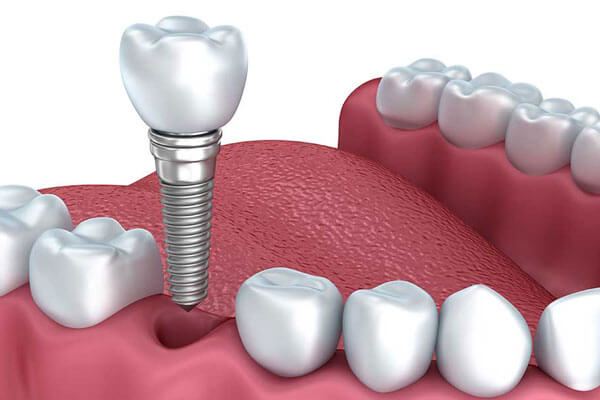When a tooth is lost there are several replacement options available today. Historically, replacement involved either a removable prosthesis or a fixed bridge. Removable prostheses are often uncomfortable to wear, difficult to chew with, and associated with damage and/or eventual loss of supporting teeth. A conventional bridge has several disadvantages including necessary preparation (grinding down) of adjacent teeth, complicated hygiene, and often a limited lifespan.
Dental implants were introduced in the early 1980’s as an alternative tooth replacement option with several distinct advantages. Dental implants are “fixed” in the mouth thereby eliminating the need for removable appliances. They do not require preparation or damage adjacent teeth. Most importantly, studies indicate that implants have a much higher success rate compared to bridges or removable appliances (most studies indicate implant success rates in the 95-98%).

Dental implant treatment consists of two steps; the placement of the implant and the restoration of the final crown. In the first step, the doctor places the dental implant in the jaw bone.
If a tooth is present and needs to be removed, often the implant can be placed in the same visit. Our Doctors have developed several techniques to make this step as least-invasive as possible. Patients typically experience very little post operative discomfort. After placement, the implant needs to heal in the bone for 3-4 months undisturbed. After the healing period, the patient is referred back to their restorative dentist for placement of the final crown.
Dental implants are used today to improve the quality of life of denture wearers.
Totally edentulous (missing all teeth) patients are faced with several challenges including difficultly eating, speaking and facial profile changes. Dentures have been the mainstay for many years in dentistry to replace complete dentitions. However, dentures have many disadvantages including lack of stability due to continued jaw bone loss, difficultly chewing and eating, and pain from rubbing. In fact, because of these issues the World Health Organization classifies complete edentulism as a physical disability. Dental implants are now used to stabilize dentures or permanently attach dentures thus eliminating many of these challenges. To learn more about dental implants and dentures, contact Burke Periodontics and Implant Dentistry at 262-240-9840.
